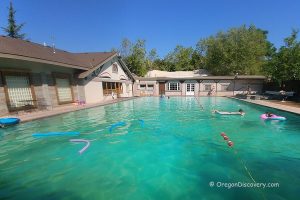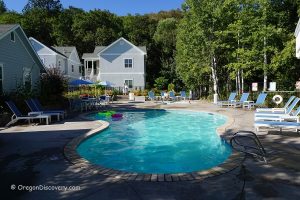
• Table Rocks are the two most distinguished Rogue River Valley volcanic formations
• The preserve is a habitat for hundreds of plants and animals - some are unique to this area
The Table Rocks are the two most distinguished Rogue River Valley volcanic formations. Upper Table Rock and Lower Table Rock sit on the north bank of the Rogue River, just a short drive away from Medford.
The names of the two formations are not based on the height but rather on their positions, with Lower Table Rock sitting downstream from Upper Table Rock. Both rocks rise around 800 feet above the Rouge River.
The two most entertaining adventures here are hiking and nature viewing. And do not forget about the Rouge River and the Rogue River Valley! The valley is a paradise for outdoor enthusiasts with opportunities for fishing, boating, swimming, camping, and picnicking.

Formation
The two impressive buttes were formed about 4-5 million years ago during a major Cascade eruption. Basalt lava covered the sandstone, creating mountain-like formations.
While the hardened lava is erosion-resistant, the sandstone underneath the hardened caps did erode over time. As a result, heavy basalt collapsed under its weight, leaving the nearly vertical walls we see today.
Native Americans and First Settlers
The Table Rocks area had been home to Native Americans for over 15,000 years before the arrival of European settlers. During the mid-19th century, gold rush enthusiasts started arriving in huge numbers. Conflicts with the native population were the predictable outcome.
In the 1850s, the Table Rocks were the site of a historic battle during the Rogue River Indian Wars. Major Philip Kearny led the displacement of the Rogue (Takelma) tribe, forcing them into reservations. Many settlers arrived after the events and quickly developed the area. The Town of Table Rock post office was established in 1872.

20th Century Development and Protection
In 1948, Lower Table Rock got an airstrip. In the 1960s, Upper Table Rock got the VOR aviation tower. In the 1970s, the Table Rocks finally became a protected area to preserve its geological and biological diversity and avoid damage caused by further development.
In the early 1980s, the Oregon Department of Forestry, Boy Scouts, and the Youth Conservation Corps created the Lower and Upper Table Rock trails.
In 1984, the Table Rocks were designated as an Area of Critical Environmental Concern to safeguard unique geology, fauna, and flora. That helped preserve the Table Rocks and the surrounding area until today. It is now a prime location to enjoy rare geological phenomena, hike trails to the impressive vistas, and see rare plants.

Things To Do at Table Rocks
Hiking
The Table Rocks are one of the most visited hiking destinations in the Rogue Valley. It is estimated that more than 45,000 people visit this location every year.
Two major trails are leading up to each Table Rock.
The trail to Upper Table Rock is an easy 2.5-mile loop with 720 feet of elevation gain.
The path up Lower Table Rock is a moderate 3.5-mile loop with 780 feet of elevation gain. It is also rockier than the one to Upper Table Rock.
The two trails will take you to the respective tops of this magnificent Rouge Valley phenomenon. You do not have to wait until you reach the summits, though. Look around while you climb – the views are amazing.

Nature Viewing
The Table Rocks are a protected area with hundreds of plants and animals. Some are so unique you can only find them here. Vernal pool fairy shrimp and dwarf woolly meadowfoam are among them.
The vernal pool fairy shrimp is a federally listed threatened species inhabiting the seasonal pools that form in shallow depressions on the surface of the lava rock. The dwarf woolly meadowfoam is a herb unique to this area that blooms in the spring.
Spring is the best time to visit overal - more than 200 wildflower species start blooming at that time, creating a beautiful palette of color combinations.
As you ascend to the summit, you can see the Pacific madrone, white oak, manzanita, and ponderosa pine surrounded with grass and wildflowers. The evergreen madrone trees are the most notable for their glossy, peeling leaves.
Table Rocks | Facts
Open: Year-round
Managed by: The Nature Conservancy (3,591 acres) and BLM (1,280 acres)
Location: The Rogue River Valley
Amenities: Restrooms
Activities: Hiking and nature viewing
Distance from the parking: Short
Road access: Any passenger vehicle
Day-use fees: None
Elevation: 1300 ft (396 m)
Table Rocks are located:
- 11 miles north of Medford
- 31 miles east of Grant Pass
- 98 miles southeast of Roseburg.
Adventures Nearby
Directions to Table Rocks
From Medford to Upper Table Rock Trailhead,
- Take Table Rock Road West
- Turn right onto Modoc Road for 1.5 miles.
10395 Modoc Rd, White City, Oregon 97503
From Medford to Lower Table Rock Trailhead,
- Take Table Rock Road West
- Turn left onto Wheeler Road and follow it for 0.8 miles
- Turn left onto Cornerstone Road.
Phone: 541-6182-200
blm.gov








